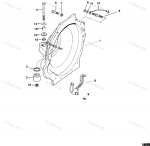So I have my new 4.3 in from Atlantic Motors. 2 Barrel Mercarb.
Ole Engine Serial was 0M078233
New circulation pump, New impeller and housing (quicksilver), new thermostat (Mercury from marina next door), New water Tubes in the out drive (quicksilver).
Flushed and inspected Manifolds. Inspected Flappers in Exhaust A-OK As well.
Started engine and set timing. Starboard Riser is cooler than port until T-Stat opens, then starboard riser heats up till is is 30 degrees hotter than port. IR Thermometer reads 133F on Starbort and 99F on port.
It seems like the hose going to the bottom of the multi piece manifolds (not the batwings) stay water supply temp until the thermostat opens up, then the starboard feed to the exhaust is only getting warm water while the port is getting the cold water. I used a wire and a flashlight to check for blockages in the T-Stat housing, there isn't any.
Is this normal? OK?
Also, Video below, is this much valve noise normal for a freshly rebuilt engine?
https://youtu.be/J5IMpVTNKhQ
Ole Engine Serial was 0M078233
New circulation pump, New impeller and housing (quicksilver), new thermostat (Mercury from marina next door), New water Tubes in the out drive (quicksilver).
Flushed and inspected Manifolds. Inspected Flappers in Exhaust A-OK As well.
Started engine and set timing. Starboard Riser is cooler than port until T-Stat opens, then starboard riser heats up till is is 30 degrees hotter than port. IR Thermometer reads 133F on Starbort and 99F on port.
It seems like the hose going to the bottom of the multi piece manifolds (not the batwings) stay water supply temp until the thermostat opens up, then the starboard feed to the exhaust is only getting warm water while the port is getting the cold water. I used a wire and a flashlight to check for blockages in the T-Stat housing, there isn't any.
Is this normal? OK?
Also, Video below, is this much valve noise normal for a freshly rebuilt engine?
https://youtu.be/J5IMpVTNKhQ




















